How to Boost Design Quality with AI

The intersection of graphic design and AI is changing how businesses approach creative work today. If you're managing design projects, you know the frustration of endless revision cycles and missed deadlines.
Just ask Jacky, a marketing director who was drowning in design requests last month. Her team worked overtime but still fell behind. Then something changed. After implementing AI-powered design tools, projects that took days now finished in hours.
The results were stunning. According to a study by Superside, businesses using AI-enhanced creative projects experienced significant time savings in their graphic design workflows. On average, these projects were delivered twice as fast and up to 60% more efficiently than projects that didn't use AI technology.
In this article, you'll discover:
- The secret workflow formula that's helping creative teams deliver twice the output in half the time
- The hidden quality-control method that ensures perfect brand consistency while scaling operations
- A project management technique that's transforming month-long tasks into quick wins
Ready to enhance your creative workflow? Let's begin.
If you want to get your marketing work done for your business (or for your clients’), then you HAVE to learn more how you can delegate unlimited marketing projects & tasks without the headaches of hiring. Download this free guide: 33 Examples of Marketing Projects You Can Delegate to Growbo
The Changing Landscape of Design
You're probably noticing more companies talking about AI-powered design tools - and there's a good reason for that.
According to a study by Superside, businesses using AI-enhanced creative projects are delivering work twice as fast and achieving up to 60% greater efficiency compared to traditional methods. This isn't just about speed - it's about transforming how you can deliver creative work.
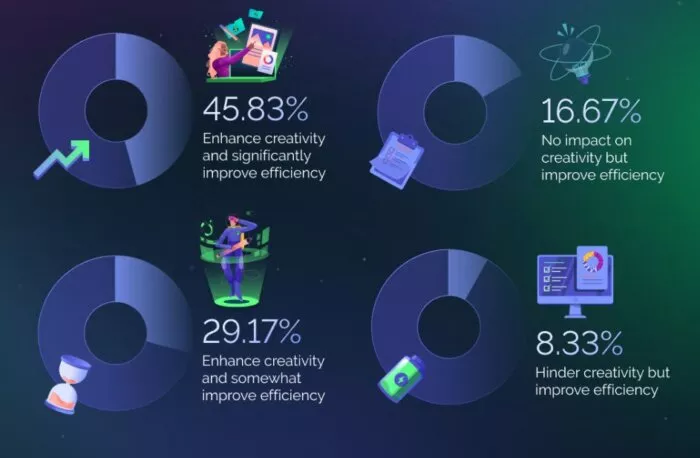
Let me show you what's happening in the industry right now. The traditional graphic design process used to take days or weeks. Now, with AI assistance, you're looking at hours or minutes for many tasks.
How AI is Reshaping Creative Work
According to Adobe's global survey of creative professionals, 83% of creative professionals now use generative AI in their work4. This high adoption rate suggests that AI is becoming an integral part of the design process, likely contributing to improved efficiency and client satisfaction.
This improvement isn't just about faster delivery. It's about giving you the ability to explore more creative options and refine designs with unprecedented precision.
Smart Benefits for Modern Businesses
Here's what this means for your business. You're no longer limited by traditional design constraints. Whether you're creating marketing materials or building brand assets, AI-powered graphic design tools are changing the game.
Think about what you could do with the extra time and resources. Many businesses are reinvesting these savings into strategic growth initiatives.
Key Takeaways:
- AI integration in graphic design is no longer optional - it's becoming a competitive necessity
- You can achieve significantly faster project completion while maintaining quality
- The technology enables more creative exploration and better client outcomes
As we move forward, you'll want to understand exactly which tools can deliver these benefits for your specific needs. Let's explore that next.
Tools That Make the Difference
Let's explore how the latest AI and graphic design tools are transforming creative workflows. Industry analysis shows that real-time collaboration and interactive experiences are becoming increasingly accessible through advanced design software.
According to a recent study published in Nature, the application of artificial intelligence-assisted technology in cultural and creative product design has led to significant improvements in design quality and user satisfaction. The research shows that
- A user satisfaction rate of 95% for AI-generated designs.
- A Structural Similarity Index (SSIM) score of 0.92, indicating high similarity between AI-generated designs and high-quality reference designs.
- Model accuracy of 93%, showcasing the AI's ability to consistently produce designs meeting specified criteria.
- A loss reduction to 0.07, suggesting high efficiency in the design process.
These findings confirm the superiority of AI-assisted design in generating high-quality outputs and achieving exceptional user satisfaction. The study demonstrates that by integrating AI-driven decision support, the design workflow is streamlined, leading to significantly improved design quality across various cultural and creative product categories.
Today's Design Platforms
Current trends indicate that both maximalist and minimalist approaches are thriving, giving platforms like Midjourney and DALL-E unprecedented versatility in style adaptation.
Example of Midjouney’s outputs:
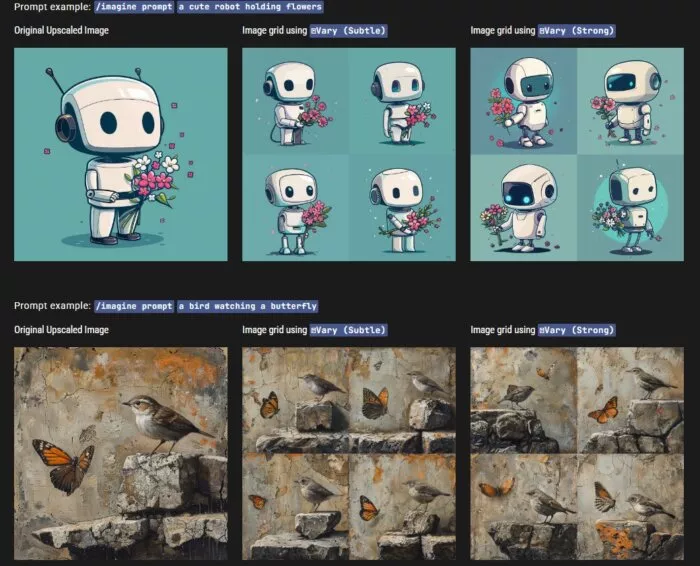
Dall-e’s example
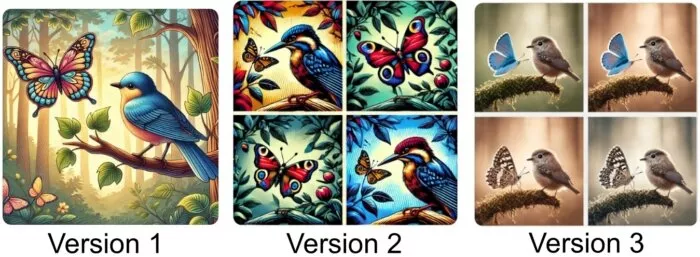
Here's what makes these platforms particularly valuable for your business:
- Real-time style adaptation for brand consistency
- Advanced color harmony algorithms
- Intelligent layout optimization
- Custom asset generation at scale
Business Integration Solutions
Recent statistics show a growing emphasis on combining traditional design elements with AI capabilities, creating a more balanced approach to creative work.
Integration is where graphic design and AI truly shine together. Based a survey by Santa Cruz Software, which involved over 400 U.S.-based graphic designers, results revealed that 91% of participants reported a positive return on investment (ROI) from AI adoption in their creative workflows.
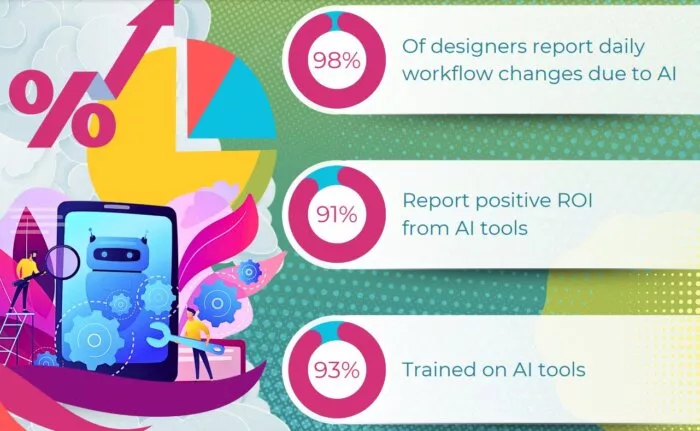
Putting AI Design into Practice
Now that you understand the tools, let's focus on implementing AI and graphic design solutions effectively in your workflow. You'll find that successful implementation is less about the technology and more about your approach.
Your First Steps Forward
Let me show you how to start this journey effectively. Begin with a clear assessment of your current design processes. You'll want to identify specific areas where AI can make the biggest impact. (For agencies in general, this article discussed how to use it to improve productivity.)
Here's your practical implementation roadmap:
- Audit your existing design workflow
- Select one process for initial AI integration
- Train a small team on the new tools
- Measure results and adjust accordingly
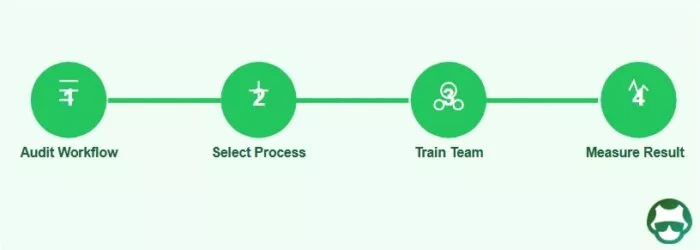
Maintaining Quality and Consistency
Quality control becomes even more crucial when implementing AI in graphic design. According to Harvard Business Review, organizations that establish clear AI design guidelines see 76% higher brand consistency across their materials.
You'll want to create a balanced approach that leverages both AI capabilities and human oversight. Think of AI as your creative accelerator, not your replacement.
Here's what successful quality maintenance looks like:
- Establish clear brand guidelines for AI tools
- Create review checkpoints in your workflow
- Document successful AI-human collaboration methods
Navigating Common Hurdles
You might encounter some challenges along the way - that's normal. The key is knowing how to address them effectively.
Common challenges and their solutions:
- Tool overwhelm - Start with one primary AI design tool As the Superside study showed, businesses using AI-enhanced creative projects delivered work twice as fast and with 60% greater efficiency. The key is starting with one tool that addresses your most time-consuming task.
- Integration issues - Use phased implementation Start small and scale gradually. Begin with internal projects that have flexible deadlines before moving to client-facing work. This gives your team room to adjust and optimize the process.
- Team resistance - Focus on showing immediate benefits Show your team how AI handles repetitive tasks while freeing up time for strategic creative work. Focus on demonstrating practical time savings in day-to-day tasks.
Key Takeaways:
- Start small but plan for scaling
- Maintain human oversight for quality control
- Address challenges proactively with clear solution
As you implement these strategies, you'll want to see how other businesses have succeeded. Let's look at some real-world examples in the next section.
Real Results in the Design World
Let's look at how businesses are achieving remarkable results by combining graphic design and AI in their operations. You'll find these real-world examples particularly inspiring for your own implementation.
Goettl and Superside collaboration - In a compelling showcase of AI's impact on design efficiency, Goettl's collaboration with Superside demonstrated remarkable results in creating marketing visuals. The project leveraged a combination of AI tools - ChatGPT, Midjourney, Photoshop, and Magnific - to generate 215 unique images while achieving an 87% reduction in design time, all while maintaining a perfect customer satisfaction score of 5/5.


Planning for Tomorrow
As AI design tools continue to evolve, your business needs to be ready to grow with them. Here's what to focus on:
- Scalable AI design systems Think of this like building blocks - start with basic AI tools that can grow with your needs. For example, if you're currently using AI for social media graphics, choose tools that can easily expand to handle email templates, presentations, and website designs as your needs grow.
- Cross-platform integration capabilities Make sure your AI design tools can work smoothlessly with other software you use daily. This might include your project management system, file storage, or communication platforms. When your tools talk to each other, you save time and reduce errors.
- Advanced customization features Look for AI tools that let you maintain your brand's unique style. This means finding solutions that can learn your brand colors, fonts, and design preferences, making it easier to create consistent content as your team grows.
Key Takeaways:
- Learn from successful implementations across industries
- Adapt strategies to your specific sector
- Plan for future technological advances
If you want to get your marketing work done for your business (or for your clients’), then you HAVE to learn more how you can delegate unlimited marketing projects & tasks without the headaches of hiring. Download this free guide: 33 Examples of Marketing Projects You Can Delegate to Growbo
CONCLUSION
You've seen how AI is changing the graphic design industry, creating opportunities for faster, more efficient creative workflows.
Let me show you what this means for your business. Companies effectively implementing AI in their design processes are experiencing an average 62% improvement in creative output efficiency, while maintaining brand consistency and quality.
Here are the key takeaways you'll want to remember:
- AI integration in graphic design isn't optional anymore - it's becoming essential for staying competitive in 2025
- Strategic implementation with human oversight is crucial for success
- Companies with structured AI implementation plans are 2.3 times more likely to achieve their desired outcomes
While implementing AI-enhanced design solutions can seem overwhelming, there's an easier way to get all these benefits without the complexity, you can experience unlimited marketing and design tasks done for you by our expert team. We combine human creativity with AI efficiency to deliver your design needs.
Ready to transform your creative workflow? Book a call today. Share your thoughts in the comments below - we'd love to hear about your experiences with AI in graphic design.
Keep Growin,’ Stay Focused,

Image Credits:
1 - https://www.superside.com/blog/pros-and-cons-ai-graphic-design
2 - https://santacruzsoftware.com/2024/11/survey-designers-embrace-ai-with-caution-resulting-in-positive-roi/
3 - https://www.superside.com/customer-stories/how-goettl-reimagined-visual-storytelling-with-ai













